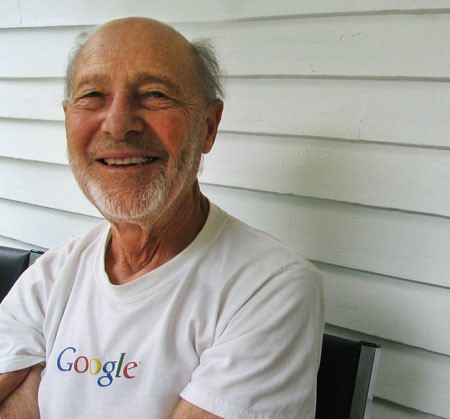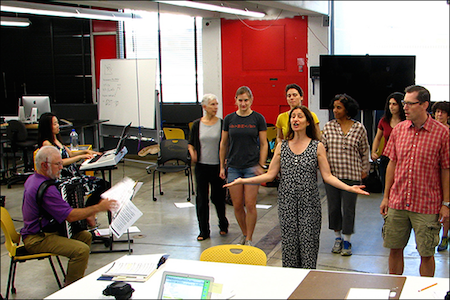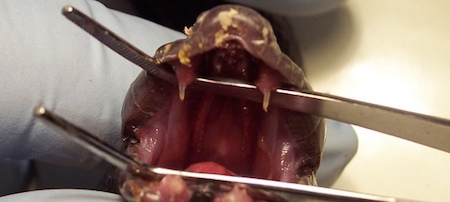Marc Abrahams's Blog, page 307
September 15, 2015
Ig Nobel winner de Waal savors newly-discovered relatives
Ig Nobel Prize winner Frans de Waal speaks his piece about the newly-discovered early-human-relative fossil, in an op-ed piece in the New York Times.
The 2012 Ig Nobel Prize for anatomy was awarded to Frans de Waal and Jennifer Pokorny for discovering that chimpanzees can identify other chimpanzees individually from seeing photographs of their rear ends. (Their study about that: “Faces and Behinds: Chimpanzee Sex Perception” Frans B.M. de Waal and Jennifer J. Pokorny, Advanced Science Letters, vol. 1, 99–103, 2008.) The new essay begins:
Who Apes Whom?
WHEN I learned last week about the discovery of an early human relative deep in a cave in South Africa, I had many questions. Obviously, they had dug up a fellow primate, but of what kind?
The fabulous find, named Homo naledi, has rightly been celebrated for both the number of fossils and their completeness. It has australopithecine-like hips and an ape-size brain, yet its feet and teeth are typical of the genus Homo.
The mixed features of these prehistoric remains upset the received human origin story, according to which bipedalism ushered in technology, dietary change and high intelligence.…

Karen Brown’s appreciation of Joe (teapot/ponytail) Keller
Karen Brown visited two-time (1999 and 2012) Ig Nobel physics prize winner Joseph Keller, and wrote about it, on the Etsy blog. Here is the beginning of her essay:
The Teapot Effect: Why Teapots Drip

“Joseph B. Keller is an immensely distinguished scientist. Professor Emeritus in engineering and mathematics at Stanford University, he may be known best for the Geometrical Theory of Diffraction and the Einstein–Brillouin–Keller method.
 “But his major work – honored with awards that include the National Medal of Science and the Wolf Prize – might not fully convey Dr. Keller’s sense of playful enthusiasm and perpetual curiosity.
“But his major work – honored with awards that include the National Medal of Science and the Wolf Prize – might not fully convey Dr. Keller’s sense of playful enthusiasm and perpetual curiosity.
What sparks the curiosity of a man who has attended lectures with Einstein and partied at Heisenberg’s house? For one, Joseph Keller is into teapots. Really into teapots. In fact, he is the world’s recognized expert on why teapots drip.
“Like many of us, Dr. Keller had long observed the pesky problem of that little bit of tea that always seems to run down the outside of the spout and drip into our laps. “Then, in 1956, I heard a lecture,” he told me. “An Israeli scientist reported he asked 100 physicists why teapots drip and they all said it was due to surface tension. This scientist did some experiments that proved it couldn’t be caused by surface tension, so what is the explanation? I wrote a paper, ‘The Teapot Effect,’ shortly thereafter, showing that the effect occurred through fluid and mechanical forces.…”


May: Wee
To wee, or not to wee? Oui? Non? Maybe? This medical report addresses all those questions:
“Differential Diagnosis: Urination Disorders,” F. May, Medizinische Klinik (Munich, Germany: 1983) 47, no. 14 (1952): 441.

Norwegian TV preview of the Ig Nobel Prizes
NRK, the Norwegian TV network, previews the Ig Nobel Prize ceremony:
The Schrödingers katt science TV program, on NRK, recently celebrated some of Norway’s Ig Nobel Prize winners — and several other Ig Nobel Prize winners, too.

September 14, 2015
The physics space of opera rehearsal
A big Thank You to the Harvard Physics Department for again letting us use the SciBox for rehearsals of a new Ig Nobel mini-opera. This photo was taken by David Kessler:
The opera will premiere this Thursday night, Sept 17, as part of the Twenty-Fifth 1st Annual Ig Nobel Prize Ceremony, at Sanders Theatre. The entire ceremony will be webcast live. We hope you will gather friends together, and watch!

Ig Nobellian Milken, junk-bond king, now crusades for cures
Michael Milken, who was awarded the 1991 Ig Nobel Prize for economics, has become a crusader for medical legislation and funding.
The Ig Nobel prize cited Milken as “father of the junk bond, to whom the world is indebted“. Sheila Kaplan, reporting for STAT, profiles Milken’s recent activities:
WASHINGTON — Nearly 1,200 lobbyists roamed the halls of Congress this year, trying to shape legislation to speed up the federal approval of new drugs and expand medical research. But the advocate who arguably has had the biggest impact on the process isn’t a registered lobbyist at all. It’s onetime junk bond king Michael Milken.
A 1980s icon of excess, Milken pleaded guilty in 1990 to six criminal charges stemming from securities transactions. He was initially sentenced to 10 years in prison, ultimately serving 22 months and paying $1.1 billion in fines and settlements.
But that was then. Today, after years building a reputation as one of the nation’s leading medical philanthropists, Milken has quietly added politics to his portfolio.
He has pushed his agenda with a muted public presence, one that stresses quiet messaging over press releases and networking over campaign contributions. His goal is passage of the 21st Century Cures Act, a bill that would accelerate regulators’ review of new medical treatments and boost funding for the National Institutes of Health by nearly $9 billion over five years….

Prize-winning cat-on-your-keyboard detector
Here’s an appreciative look at the Ig Nobel Prize-winning cat-on-your-keyboard detector. Zachary Crockett writes, on the Priceonomics blog:
The Software That Detects When a Cat Is Messing with Your Keyboard
… While 140 Ig Nobel prizes have been doled out in history, only one has been awarded in the category of “computer science.” This distinct honor goes to PawSense, a software designed to detect when a cat walks across a computer keyboard.
As cat owners all too familiar with this phenomenon, we had to find out what PawSense was all about.
***
After earning a degree in computer science from Arizona State University in the mid-90s, Chris Niswander spent his post-college days coding puzzle mazes, building Japanese language learning programs, and building python obfuscators. Then, somewhat fortuitously, the idea of the century descended upon him.
“One day, my sister’s cat, Amos, walked across her computer keyboard and managed to uninstall some software, delete crucial files, and crash the machine,” Niswander recalls. “I figured out that he’d triggered a series of keyboard shortcuts (ALT, CTRL, F1-F2) with his paws….”
BONUS: Here’s video of a performance of the song “Kitten on the Keys”:

Empty Photographic Frames : Punctuating the Narrative
Nancy Pedri, who is Associate Professor in the Department of English and Literature at the Memorial University of Newfoundland, is a comparatist. And, as such, is one of the few scholars to have examined the implications of empty photographic frames in multimodal narratives.
“
In its capacity to open up the possibility for variance in meaning, the empty frame serves as a boundary that distinguishes a focused showing and seeing from an indeterminate, wondering seeing. Its contours highlight the fact that something must be perceived or seen, but that that something comes not from within the frame, not from what is imaged on the photograph’s surface, but rather from outside of it. It is in this sense that the frame accentuates absence and incompleteness as crucial to photographic meaning.”
See: ‘Empty Photographic Frames. Punctuating the Narrative’ in IMAGE [&] NARRATIVE, Vol 15, No 2 (2014).
Note: The example empty frame, reproduced in the paper, is from ‘The Collected Works of Billy the Kid’, by Michael Ondaatje.

September 13, 2015
Teaser for the 2015 Ig Nobel Prize ceremony
Here’s a video teaser for the Twenty-Fifth 1st Annual Ig Nobel Prize ceremony. The ceremony happens this Thursday evening, September 17, 2015, beginning at 6:00 pm [U.S. eastern time] You can watch the live webcast here at Improbable.com
BONUS (about Daniel, who stars in the teaser): What else does that performing chemist perform?

The Living Hazards Database
The US Armed Forces Pest Management Board presents…
The Living Hazards DatabaseThe Living Hazards Database (LHD) is a comprehensive compilation of more than 500 species worldwide, which are reported to cause serious injury or death of humans…. Information on each species listed includes: description, habitat, behavior, known harmful effects, geographic distribution, taxonomy, and a representative image for most species.
Here’s one item from the LHD. It’s called Walterinnesia aegyptia:
(Thanks to Brendan Koerner for bringing this to our attention.)

Marc Abrahams's Blog
- Marc Abrahams's profile
- 14 followers






